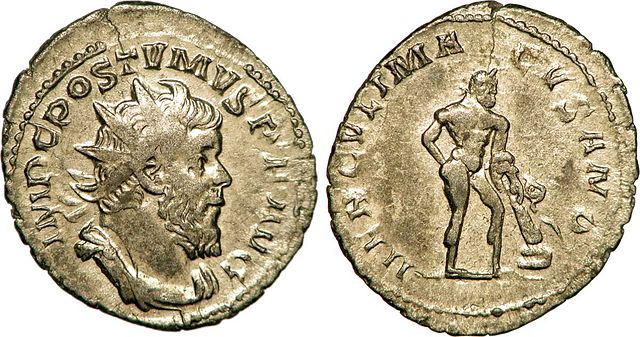Marcus Cassianius Latinius Postumus was a Roman commander of Batavian origin, who ruled as emperor of the splinter state of the Roman Empire known to modern historians as the Gallic Empire. The Roman army in Gaul threw off its allegiance to Gallienus around the year 260, and Postumus assumed the title and powers of Emperor in the provinces of Gaul, Germania, Britannia, and Hispania. He ruled for the better part of ten years before he was murdered by his own troops.
Antoninianus of Postumus: IMP. C. POSTVMVS P. F. AVG
Milestone of Postumus c.261-269 found in Vitoria-Gasteiz, Spain. It bears the inscription: [I]MP(ERATORI) CAE[S(ARI)] [M]ARCO CA[SSIJANO] LAT[IN]IO POSTUMO AUG(USTO).
An antoninianus of Postumus. Legend: IMP. C. POSTVMVS P. F. AVG.
Antoninianus struck under Aureolus; Mediolanum (Milan) mint, AD 268. Left: Radiate, draped, and cuirassed bust Right: Hercules standing right, holding lion skin and club resting on rock
The Gallic Empire or the Gallic Roman Empire are names used in modern historiography for a breakaway part of the Roman Empire that functioned de facto as a separate state from 260 to 274. It originated during the Crisis of the Third Century, when a series of Roman military leaders and aristocrats declared themselves emperors and took control of Gaul and adjacent provinces without attempting to conquer Italy or otherwise seize the central Roman administrative apparatus.
Coin of Tetricus, last emperor (271–274) of the Gallic Empire


![Milestone of Postumus c.261-269 found in Vitoria-Gasteiz, Spain. It bears the inscription: [I]MP(ERATORI) CAE[S(ARI)] [M]ARCO CA[SSIJANO] LAT[IN]IO PO](https://upload.wikimedia.org/wikipedia/commons/thumb/d/dc/PostumusMilestoneAraba.jpg/450px-PostumusMilestoneAraba.jpg)


